This webinar features Beth Shaver and provides resources for collecting Social Studies resources from multiple perspectives. Click here to access.

This webinar features Beth Shaver and provides resources for collecting Social Studies resources from multiple perspectives. Click here to access.

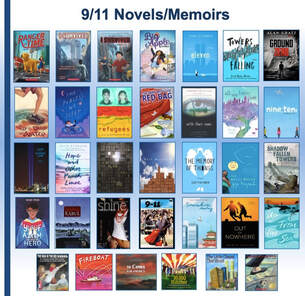
This blog is written by Lesley Roessing suggesting that a variety of texts can be used to teach historical events still impacting the world today. Read more about Lesley at the bottom of her post.
No historical event may be as unique and complicated to discuss and teach as the events of September 11, 2001, the day terrorists crashed planes into, and destroyed, the Twin Towers of the World Trade Center. At the time of this event, no child in our present K-12 educational system was yet born, but, in most cases, their parents and educators would have been old enough to have some knowledge of, and even personal experience with, these events, making this a very difficult historic event for many to teach. However, with the devastation and impact of these events on our past, present, and future and as ingrained a part of history these events are, they need to be discussed and understood as much as possible.
An effective way to learn about these events is through story. Powerful novels have been written about this tragedy, for all age levels and, fascinatingly, each presents a different perspective of the events. Some take place during September 11, some following the events, some a few years later or many years later, and a few include two timelines. Many take place from the perspectives of multiple characters.
On September 11, 2021, YA Wednesday posted my guest-blog “Novels, Memoirs, Graphics, and Picture Books to Commemorate September 11th.” In this blog, I interviewed authors and reviewed and recommended 24 texts and six picture books.
Since then, I have read two additional texts:
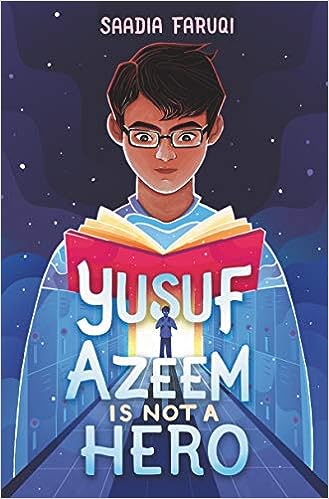
Yusuf Azeem is Not a Hero by Saadia Faruqi
“Suspicion of those unlike us is common human behavior. We don’t trust who we don’t know. But yes, 9/11 was terrible, and it really fueled the fire of hatred in this country.” (184-5)
Sixth grader Yusuf Azeem was born in Texas and is an American; his mother was also born in America and his father was a Pakistani immigrant who runs the popular A to Z Dollar Store in town (and a somewhat a local hero after capturing an intruder threatening his store and customers). The family is Muslim, but, understandably, Yusuf is shocked when sixth grade begins with threatening notes in his locker. When one says, “Go home,” he is hurt and confused. Frey, Texas is his home. Surely the notes are meant for someone else.
This is a novel that may benefit from some background on the events of September 11, 2001, since the action takes places in 2021 but, read individually, Ausuf’s uncle’s journal helps to fill in information. The importance of this particular novel is that it demonstrates that, for some of our citizens and students, “Twenty years. So much time. But things haven’t really changed at all.” (48) One of the major events in the story—when a little computer in his backpack beeped and, instead of questioning him and investigating, Ausuf is thrown in jail for twelve hours—is based on a real event from 2015 where Ahmed Mohamed, a Muslim 14-year-old, was arrested at his high school because of a disassembled digital clock he brought to school to show his teachers [https://www.cnn.com/2015/09/16/us/texas-student-ahmed-muslim-clock-bomb].
It is vital that our children learn about 9/11 because, as Yusuf’s mamoo says, “History informs our present and affects our future.” (81)
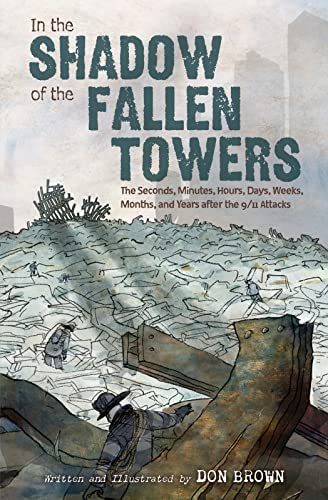
In the Shadows of the Fallen Towers by Don Brown
Don Brown’s graphic novel recounts events following the 9/11 attacks on the Towers and the Pentagon from the moment of the “jetliner slamming into the North Tower of the World Trade Center” to the one-year anniversary ceremonies at the Pentagon, in Shanksville, Pennsylvania, and at Ground Zero. It also covers the fighting of U.S. troops in Afghanistan and the capture and interrogation of prisoners from an al-Qaeda hideout in Pakistan.
The drawings allow readers to bear witness to the heroism of the first responders, firefighters, and police as they move from rescue to recovery over the ten months following the attacks and learn the stories of some of the survivors they saved. It is the story of the nameless “strangers [who] help[ed] one another, carrying the injured, offering water to the thirsty, and comforting the weeping.” (23)
We learn and view details that we may have not known, such as “Bullets start to fly when the flames and heat set off ammunition from fallen police officers’ firearms,” (11) the “Pentagon workers [who] plunge[d] into the smoke-filled building to restore water pressure made feeble by pipes broken in the attack,” (36) and former military who donned their old uniforms and “bluff[ed their way] past the roadblocks” to “sneak onto the Pile” to help. (50, 52)
For more mature readers this book adds to the story of 9/11 in a more “graphic” way.
I have taught a unit on NINE ELEVEN through book clubs in multiple schools from grades 5 through 9 in both ELA and Social Studies classes. Children and adolescents have felt comfortable these sensitive and challenging concepts and examining these troubling events and some of the ensuing difficulties, prejudices, and bullying, through the eyes of characters who are around their ages, some readers sharing personal stories in their small collaborative groups. I am thankful for the authors who have allowed our children to experience these events in a safe and compassionate way. I have presented these novels and strategies and lessons for reading through book clubs at local workshops and national conferences. I included my 9/11 Book Club unit as a chapter in TALKING TEXTS: A Teacher’s Guide To Book Clubs Across The Curriculum.
Condensed and reproduced with permission from https://www.literacywithlesley.com/blog posted on September 2, 2023.

Follow her website, created to support educators—teachers, librarians, and parents, at https://www.literacywithlesley.com/

By: Kimberly Dunbar, Social Studies Teacher at Cane Bay Middle School
There was an 8.2 intensity earthquake rippling through upper elementary and middle schools classrooms in the summer 2019. After years of wrangling, new social studies standards were adopted by our State Department of Education, and there were substantial changes in content for grades 3 – 7. As usually happens, it was now up to the teachers of South Carolina to make everything work. For sixth grade teachers like me, the changes were exactly what we knew were coming but had long been dreading – we were supposed to teach all of human history in 180 days. It was difficult enough to complete when we stopped after the Age of Exploration. The task now felt unattainable.
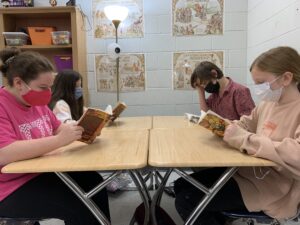
Part of what has made teaching this content so difficult is that very few students have any background knowledge about the earliest civilizations. If they do, that knowledge is usually limited (Egypt’s pyramids and mummies) or inaccurate (Greece according to Percy Jackson or 300). It’s hard for my students to make connections to material when there is no foundational information to attach to. My dilemma was how to present enough content so learners can connect the dots without overwhelming them.
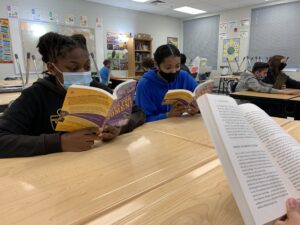
Wendy Garrett, a friend and mentor, introduced me to the idea of using historical fiction to build my students’ background knowledge. She had students participate in a class reading of a book she selected in addition to their daily warm-up questions. The thought was to kindle an enjoyment of reading AND sneak a little historical context in at the same time. Many of our students were academically below grade level and reluctant to attempt a typical novel study. We chose to scrap the usual process and keep things focused on the reading – no vocabulary, no character studies, no plot diagrams. If students ask about the meaning of a word, we’ll discuss it, try to decipher it. If students wanted to discuss things or had questions about the plot or theme, we would talk. Our intent was to present some details about ancient civilizations and historical events while we remind students how enjoyable reading could be. We let student interest guide our actions and activities. Everything was low stakes.
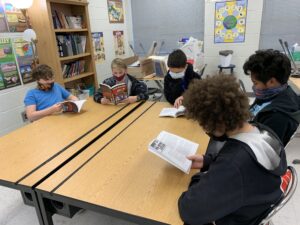
As I included daily readings into my lessons, what I found was encouraging. The first 2-3 weeks were long as I had to demonstrate and promote expected behavior during the read aloud time. When students accepted and started living into these new expectations, all of us could focus more on the information in the book. We were able to take a few minutes to practice using context clues to determine the meaning of new words. Afterwards, it became a game – who could find an appropriate time and place to use these new words. If an actual person was mentioned in our book, a student would give us a 60 second biography of the character. When an historical event was involved in the story, someone gave us a quick recap of what happened. The payoff came when students saw these same people and events in our regular class discussions and were able to recall information we had covered before. I could take another minute and help students put together the cause-and-effect of concepts we were learning. Lots of wins on multiple fronts!!!
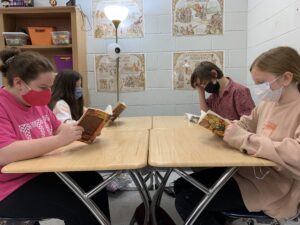
The skills that building background knowledge allows your students to practice, are the ones that will make them more engaged citizens and more valuable employees. Recognizing links between people, events and ideas are a building block of critical thinking. Critical thinkers identify situations, gather information, analyze information, and present solutions. These are the people that will make a difference in the future, if we take the time to teach them to solve problems. Teaching these new and different skills won’t be easy, but giving our students those skills will be worth every ounce of that effort.

Kim is a second-career teacher with 13 years of experience. She’s currently working to bring ancient history to life at Cane Bay Middle School in Summerville, SC.